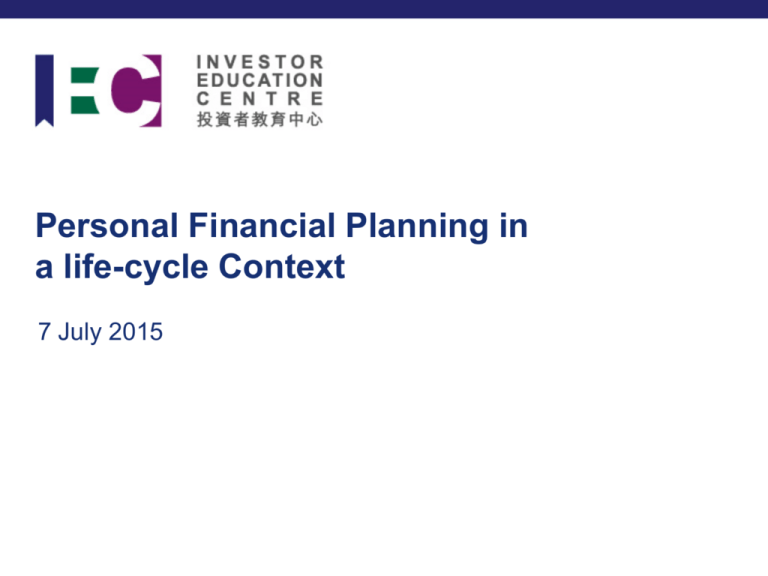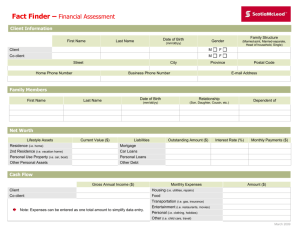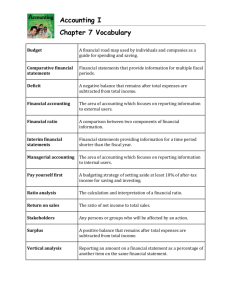
Personal Financial Planning in
a life-cycle Context
7 July 2015
Disclaimer
This presentation is intended to provide a general overview for information and educational
purposes only and is not a comprehensive treatment of the subject matter. The information is
provided generally without considering specific circumstances and should not be regarded as
a substitute for professional advice. The Investor Education Centre (“IEC”) has not advised
on, passed on the merit of, endorsed or recommended any of the products/services or types of
products/services referred to in this presentation. Readers/Audiences should seek
professional advice if they consider necessary.
The IEC endeavours to ensure that the information contained in this presentation is accurate
as of the date of its presentation, but the information is provided on an "as is" basis and the
IEC does not warrant its accuracy, timeliness, or completeness. The IEC has no obligation to
update this presentation as law and practices change. In no event shall the IEC accept or
assume any liability (including third party liability) nor entertain any claim for any loss or
damage of any kind howsoever caused arising from or in connection with the use of or reliance
upon this presentation (including whether caused by the IEC’s negligence or any error or
omission in information or otherwise).
Examples and case studies provided in this presentation are for educational purposes only. All
background information, characters and situations created for the examples and the case
studies are fictitious.
Copyright for presentations
The Investor Education Centre (“IEC”) is the owner of the copyright and other intellectual
property rights in this presentation. This presentation (in whole or in part) may not be
reproduced or distributed, or used for commercial purposes, without the prior written
permission of the IEC.
Copyright © 2014 Investor Education Centre. All rights reserved.
2
Contents
What is financial planning?
The financial planning process
Financial planning at different life stages
Case studies
Q&A
Are these statements correct?
One only needs to start financial planning when approaching
retirement.
Financial planning = Investing
Once you finish your financial plan, you do not have to think
about it again.
You need a lot of money to do financial planning.
What is financial planning?
Financial planning is the process of setting, planning, achieving
and reviewing your life goals through the proper management
of your finances.
The financial planning process
1
2
3
4
5
6
• Assess your financial status
• Create a budget
• Set your financial goals
• Know your risk tolerance
• Work out and implement a basic financial plan
• Review and adjust your financial plan regularly
Step 1: Assess your financial status
Assets: what you own
eg savings, investments, property
Liabilities: what you owe
eg tax bills, debt and loan
Net worth: Assets - Liabilities
Step 2: Create a budget
Track your spending
Expenses diary
Understand the nature of your expenses
Fixed vs Variable
Regular vs Occasional
Plan ahead with a budget planner
Step 2: Create a budget
Examples of common tools
•
http://www.hkiec.hk/web/en/tools-and-resources/tools/index.html
9
Step 3: Set your financial goals
Do you have any goals?
Yes
.
Travel around
the world / oneyear working
holiday
Is there any
difference between a
person without goals
and a salted fish?
No.
So what is your goal?
Buy your
dream car
Buy an
apartment
Index of saving:
Index of saving:
Get your dream
girl / boy, get
married and
have children
Be your own
boss/ start your
own business
Retirement
Index of saving:
Index of saving:
Index of saving:
Index of saving:
(Depending on how
luxurious your trip is)
(At least……)
(Well, a business is easy
to start up but hard to
maintain)
(Down payment
only…... have to repay
the mortgage for X
years)
No matter what goals you
have, saving is a must.
(or moreeeeeee)
CONCLUSION
Step 3: Set your financial goals
S
M
A
R
T
Specific
Measurable
Attainable
Realistic
Time- bound
The SMART principles can help you reach your goals step by step
3.5
11
Step 3: Set your financial goals
Different needs and goals at different life stages
Make a list of all needs and goals
Set SMART goals
Example: My laptop is out of order.
Specific - I need a new laptop.
Measurable - I need $7,500 to buy the laptop.
Attainable - I will put aside $1,500 a month to purchase the laptop.
Realistic - I can save $1,500 a month by working part-time.
Time-bound - I will save $ 7,500 in 5 months.
Map out the cost of each financial goal
Step 3: Set your financial goals
Young single
Possible goals:
• Pay off student loan
• Pay salaries tax on time
• Travel once a year
• Get married in 5 years
Step 3: Set your financial goals
Just married
Possible goals:
• Prepare emergency fund
• Prepare down payment for
a flat in 4 years
• Have a baby in 5 years
• Prepare for retirement
Step 3: Set your financial goals
Married with children
Possible goals:
• Repay mortgage on time
• Hire a maid
• Take out an insurance plan
• Save for children’s education
• Prepare for retirement
Step 3: Set your financial goals
Retiree
Possible goals:
• Preserve retirement fund
• Reserve for medical expenses
• Carry out estate planning
Step 4: Know your risk tolerance
Step 4: Know your risk tolerance
Risk tolerance
Subjective
Risk capacity
Factors
Financial goals
Time horizon (age)
Liquidity needs
Financial resources
Number of dependents
Your risk capacity will change over time and along different life
stages
Reference:
http://www.hkifa.org.hk/chi/RiskAssessmentTools.aspx
Step 4: Know your risk tolerance
Moderately
cautious
Conservative
Balanced
Moderately
aggressive
Aggressive
Step 5: Work out and implement a basic
financial plan
Prioritise your needs and goals
Identify action steps to reach your goals
Choose financial products according to your risk
tolerance and capacity
Understand your rights and responsibilities in purchasing
financial products
Maintain a diversified investment portfolio
Step 6: Review and adjust your financial plan
regularly
Be disciplined to follow the plan
Review your plan regularly
Adjust your plan if needed
Financial planning
at different life stages
22
Typical life cycle of personal income
Wealth
Consolidation
Income
Wealth
Accumulation
10
20
30
40
Wealth
Consumption
50
60
70
(Assumption: Retiring at 60)
80
90
Age
Financial planning at different life stages
Further education
Saving for flat
deposit
Building
retirement fund
Having a child
Buying a flat
Preparing for
children
education fund
Building
retirement fund
Changing to a
larger flat
Long holidays
Health care
Expanding
retirement fund
Retirement
Moving out
Getting married
Middle aged
Repaying student
loan
Starting a family
Starting work
Different life events affect what financial goals you will set
Financial goals are not static once set or achieved
They will need to be redeveloped and may even change over
time
Asset protection
Health care
Age care
Estate planning
Financial planning at different life stages
Plan according to your situation:
Age
Income and expenses
Assets and liabilities
Marital status
Family conditions
No. of dependents
Specific needs
Other constraints
•
http://www.hkiec.hk/web/en/tools-and-resources/tools/index.html
Case studies
26
Case 1: Young single – Jason
Age: 26
Occupation: Sales
Problems:
Impulse buying
Rely on tax loan to pay salaries tax
Goals:
Save for salaries tax payment
Take out a life insurance plan
Learn how to drive in 2015
Jason’s monthly expenses in May
Monthly income
$20,000
Monthly expenses
Support for parents
$0
Rent
Household and utilities
$10,000 Share the flat with friends
$1,000
Food and drink
$3,500
Transport (mostly taxi)
$800
Shopping
$5,000 Avoid impulse buying
Mobile phone plan
$400
MPF
$900
Total
$21,600
Cash flow
- $1,600
Avoid taking taxi
Select a cheaper plan
Jason’s budget planning in Jun
Monthly income
$20,000
Monthly expenses
Support for parents
$2,000
Rent
$5,000
Household and utilities
$1,000
Food and drink
$3,500
Transport
$400
Shopping
$3,500
Mobile phone plan
$200
MPF
$900
Total
Cash flow
$14,500
$5,500
The pyramid of wealth management
Distribution
• Saving
• Investment
• Estate planning
• Donation
Accumulation
• Emergency fund
• Debt management
• Insurance
Protection
30
Case 1: Young single – Jason
Prioritise goals
Higher priority:
Reserve emergency fund
Save for tax payment
Take out insurance plan
Lower priority:
Learn how to drive in 2015
How much does each of the goals cost?
Goal 1: Save for salaries tax payment
2014/15 tax payment: $6,960
Set aside $600/month
Possible action: purchase Tax Reserve Certificates (TRCs)
monthly through bank autopay
How much does each of the goals cost?
Goal 2: Take out a life insurance plan
Review insurance need
–
–
–
–
Whom or which asset do you want to protect?
What risks do you want to insure against?
How likely will the risk occur and can you mitigate against it?
What would happen to you and your family or how much would
you suffer financially if it occurs?
– How much does the insurance policy cost?
– How much can you afford to pay the premiums on certain
insurance policies with longer term?
How much does each of the goals cost?
Goal 3: Learn how to drive in 2015
Cost of a driving course in 2014: $8,000
How much will it cost in 2015?
How likely will you pass all parts of the driving test on your first
attempt?
Case 2: Married with younger children
– Mrs. Lee
Age: 35
Occupation: Housewife
Family members:
Husband: Truck driver (Age: 38)
Son: Primary 1 (Age: 6)
Family income: $18,000/month
Family savings: $3,000/month
Goal: Prepare $400,000 for her son as education fund in 12
years
Case 2: Married with younger children
– Mrs. Lee
Years of savings: 12 years
Rate of
return
Monthly saving amount
$1,000
$1,500
$2,000
0%
$144,000
$216,000
$288,000
2%
$162,597
$243,896
$325,194
5%
$196,764
$295,146
$393,528
7%
$224,698
$337,043
$449,390
9%
$257,712
$386,567
$515,423
(Correct to the nearest dollar)
Build portfolio according to risk tolerance level!
Case 3: Pre-retiree – Uncle Wong
Age: 58
Occupation: Bus driver
Family members:
Wife: Housewife (Age: 56)
Daughter: Civil servant (Age: 24)
Case 3: Pre-retiree – Uncle Wong
Risk profiles at different stages of life
–
–
–
–
–
Age: 26
Marital status: Single
Occupation: Factory worker
Lived with parents
Could afford to take on more risks
Case 3: Pre-retiree – Uncle Wong
Risk profiles at different stages of life
–
–
–
–
Age: 36
Marital status: Married
Occupation: Bus driver
Rent a flat and lived with
his wife and two-year-old daughter
– More conservative in his risk profile
Case 3: Pre-retiree – Uncle Wong
Risk profiles at different stages of life
–
–
–
–
Age: 56
Marital status: Married
Occupation: Bus driver
Lived in a flat purchased 10 years
ago under the Home Ownership
Scheme (HOS)
– Adopted a conservative portfolio
Case 3: Pre-retiree – Uncle Wong
As Uncle Wong is preparing to retire at the age of 65, he is
reviewing his investment portfolio again to manage risks.
Uncle Wong’s current portfolio:
Equities:
5% - Stock A (China Banking industry)
5% - Stock B (China Banking industry)
Bonds:
30% - RMB bonds
10% - iBond
Cash:
20% - RMB
30% - HKD
https://www.hkiec.hk/tools/fhc/tc/main/index.jsp
Diversification
Risks are unavoidable
Diversification
Investment vehicles perform differently under different
market conditions in general (eg stock vs bond)
Invest in different assets (eg stock, currency, bond)
Invest in different markets (eg regional or global investment
through funds, foreign currency deposits, etc)
Investment distribution affected by risk profile
(aggressive vs conservative)
Don’t put all the eggs in one basket
Summary
Financial planning ≠ Investing
Financial planning has to take into account the different stage
of lives – birth, working period, retirement period, etc.
A comprehensive and holistic personal financial planning
process covers a number of areas:
Cash flow management
Tax planning
Risk Management and insurance planning
Investment planning
Retirement planning
Estate planning
Visit the IEC website www.hkiec.hk
44
Thank you
45








